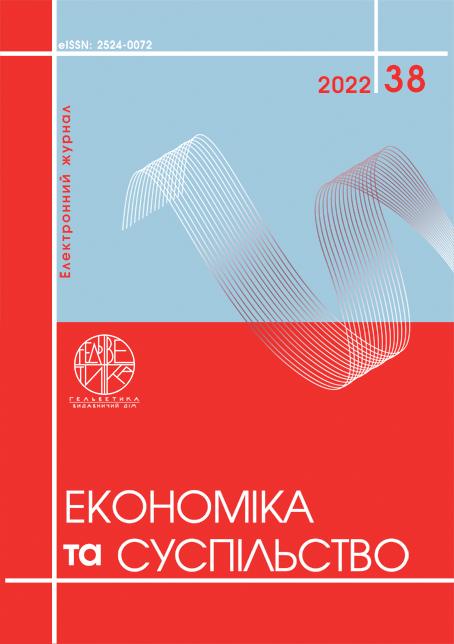THE MAIN FACTORS OF COVID-LINKED AND WAR-RELATED INFLATION
Abstract
High inflation has become again a feature of the global economic landscape like it was in the 1970s. Now, after the ‘lowflation’ of 2012–2019, it has reached the highest level in decades as a consequence of the COVID-19 pandemic and the war in Europe. The main goal of the article is to analyze and to systematize the basic determinants that impact growth in prices in the advanced countries during the last two years. Review of the existing approaches to the analysis of COVID-linked inflation reviled that many economists have demonstrated that the real inflation is even higher than the official indicators suggest. In this study we investigate the previous recession caused by the coronavirus pandemic (exogenous non-economic shock). The factors of COVID-linked inflation are grouped as determinants of aggregate demand and aggregate supply. It is noted that among all the determinants, global supply chain disruptions played a significant role promoting price level growth. The inflation, caused by the semiconductor chip shortages, has been rightly named “chip inflation”, similar to the oil-inflation in the 1970s. The war in Ukraine and the sanctions against the aggressor created additional factors that accelerated the inflation. This study found that they had the same effect – an adverse supply shock – that only added to the upward pressure on the price growth rate. Ukraine and Russia are the world’s largest exporters of many commodities. The war and sanctions have sharply curbed supply of those commodities on the global markets and have contributed to the greatest rise in energy and food prices. Other pro-inflationary factors of the war are increase of military spending and humanitarian assistance for refugees. Both create an additional burden for the government budget. The war-related recession and inflation are similar to the COVID-linked ones. Among all factors considered, the supply-chain crisis should be identified as the main one. This means a long-term inflationary effect and global consequences because repairing broken supply chains as well as forming new ones will take a long time with consequences reaching far outside of the fighting countries.
References
Baumann, P., Rossi, E. & Volkmann, A. (2021). What drives inflation and how? Evidence from additive mixed models selected by cAIC. SNB Working Papers, 12 (2021). URL: https://www.snb.ch/n/mmr/reference/working_paper_2021_12/source/working_paper_2021_12.n.pdfSuggested%20Citation
Blanchard, O. (2020). Is there deflation or inflation in our future? Vox.EU/ CEPR, Apr 24 (2020). URL: https://voxeu.org/article/there-deflation-or-inflation-our-future
Goodhart, Ch., Pradhan, M. (2020). Future imperfect after coronavirus. Vox.EU/ CEPR, Mar 27 (2020). URL: https://voxeu.org/article/future-imperfect-after-coronavirus
Higgins, M. (2021). Investors can temper their inflation fears: post-COVID inflation is unlikely to resemble the great inflation of 1968 to 1982. SSRN, Aug 15 (2021). DOI: http://dx.doi.org/10.2139/ssrn.3907668
Roubini N. (2021). The stagflation threat is real. Project Syndicate, Aug 30 (2021). URL: https://www.project-syndicate.org/commentary/mild-stagflation-is-here-and-could-persist-or-deepen-by-nouriel-roubini-2021-08?barrier=accesspaylog
Brunnermeier, M., Merkel S., Payne J. & Sannikov, Y. (2020). COVID-19: inflation and deflation pressures. Princeton University mimeo, Sep 15 (2020). URL: https://scholar.princeton.edu/sites/default/files/merkel/files/covid19inflationdisinflation.pdf
Baqaee, D., Farhi, E. (2022). Supply and demand in disaggregated Economic Review, 112, 5 (2022), 1397–1436. DOI: https://doi.org/10.1257/aer.20201229
Schacter, M. (2022). Inflation: low expectations set the stage for further surprise. The Financial Times, Apr 30 (2022). URL: https://www.ft.com/content/78d57446-0b7f-474c-998e-ccdff5ff81ea?desktop=true&segmentId=7c8f09b9-9b61-4fbb-9430-9208a9e233c8#myft:notification:daily-email:content
Cavallo, A. (2020). Inflation with COVID consumption baskets. NBER Working Paper Series, 27352, Jun (2020). DOI: https://doi.org/10.3386/w27352
Seiler, P. (2020). Weighting bias and inflation in the time of COVID-19: evidence from Swiss transaction data. Swiss Journal of Economics Statistics, 156, 13 (2020). DOI: https://doi.org/10.1186/s41937-020-00057-7
Binder, C. (2020). Coronavirus fears and macroeconomic expectations. Review of Economics and Statisetics, 102, 4 (2020), 721–730. DOI: https://doi.org/10.1162/rest_a_00931
Coibion, O., Gorodnichenko, Y. and Weber, M. (2020). Does policy communication during Covid‐19 work? SSRN Electronic Journal (2020), 1556–5068. DOI: https://doi.org/10. 3386/w27384
Candia, B., Coibion, O. & Gorodnichenko, Y. (2020). Communication and the beliefs of economic agents. SSRN Electronic Journal (2020), 1–48.
Basu K. (2022). Coordinating in the dark on inflation. Project Syndicate. Apr 29 (2022). URL: https://www.project-syndicate.org/commentary/global-monetary-policy-coordination-to-tackle-inflation-by-kaushik-basu-2022-04?barrier=accesspaylog
Moghadam R., Ranjit T. & Pelin B. (2014). Euro area – “deflation” versus “lowflation”. IMF Blog, Mar 4 (2014). URL: https://blogs.imf.org/2014/03/04/euro-area-deflation-versus-lowflation/
Kollmann, R. (2021). Effects of Covid-19 on Euro area GDP and inflation: demand vs. supply disturbances. International Economics and Economic Policy, 18 (2021), 475–492. DOI: https://doi.org/10.1007/s10368-021-00516-3
Guerrieri, V., Lorenzoni G., Straub L. & Werning I. (2022). Macroeconomic implications of COVID-19: can negative supply shocks cause demand shortages? American Economic Review, 112 (5) (2022), 1437–74. DOI: https://doi.org/10.1257/aer.20201063
Santacreu, A.M., LaBelle, J. (2022). Global supply chain disruptions and inflation during the COVID-19 pandemic. Federal Reserve Bank of St. Louis Review, Second Quarter (2022), 78–91. DOI: https://doi.org/10.20955/r.104.78-91
Leibovici, F., Dunn, J. (2021). Supply chain bottlenecks and inflation: the role of semiconductors. Federal Reserve Bank of St. Louis Economic Synopses, 28 (2021). DOI: https://doi.org/10.20955/es.2021.28
Pang I. (2021). China: PPI inflation has arrived and chip inflation is coming. ING. Think, May 11 (2021). URL: https://think.ing.com/snaps/china-ppi-inflation-has-arrived-and-chip-inflation-is-coming
Roubini N. (2021). Goldilocks is dying. Project Syndicate, Sep 21 (2021). URL: https://www.project-syndicate.org/commentary/reflation-trade-or-overheating-and-stagflation-by-nouriel-roubini-2021-09?barrier=accesspaylog


